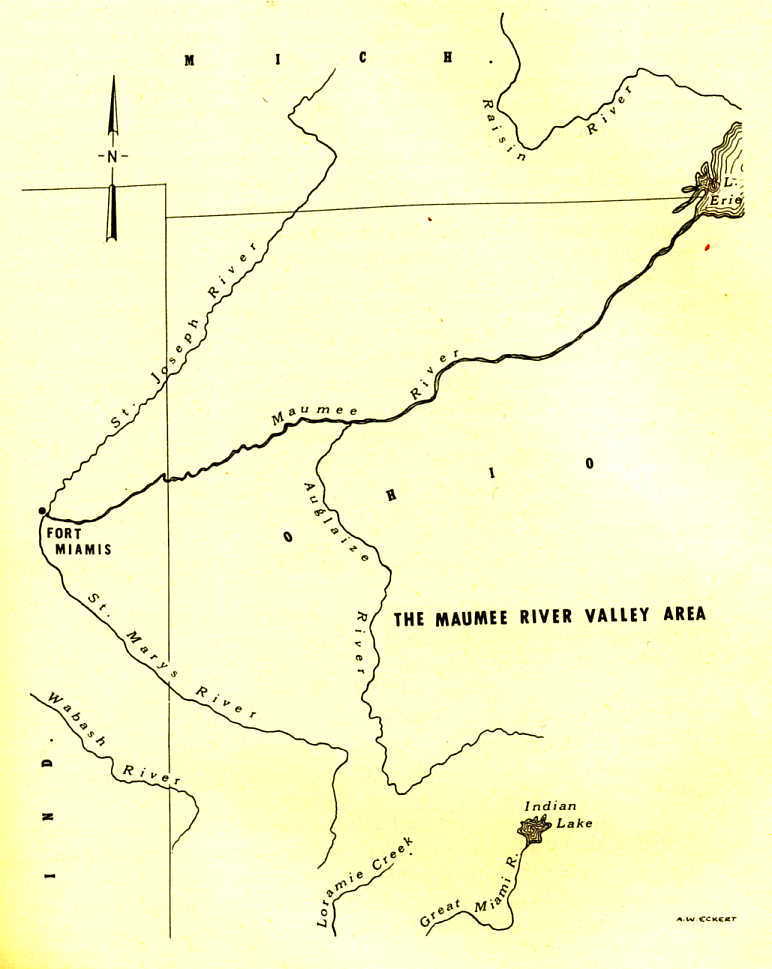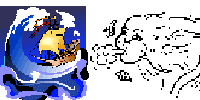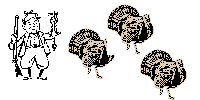
foreword | Historical Narratives | Resources | Links | Contact
TENSE TIMES ON THE MAUMEE
History is a chronicle of confrontation.
 |
|
Fort Miamis on the Maumee River |
In the Treaty of Paris, which ended the American Revolution in 1783 Section VII required His Britannic Majesty, as Thomas Jefferson, American State Secretary of State, regularly reminded the British ambassador, to withdraw from "every post, place and harbour with all convenient speed." Eleven years later the red-coated regulars of the British army were still in possession of the posts and this infuriated the Americans to no end. The British maintained they would honour Section VII when the Americans honoured the terms of treaty that dealt with compensation for the Loyalists' lost lands and stolen property. Until they did the posts were to serve as "hostages for the performance of the treaty."
Time and American tempers grew increasingly shorter and the situation was not helped in the least by Lord Dorchester who added fuel to the fire by assigning Simcoe a controversial mission on 17th February, 1794. The Governor of Upper Canada was ordered to proceed to the Ohio country where he was to re-occupy and restore a fort on American territory situated near the rapids in the Maumee River. The British had partially demolished this fort when they evacuated it following the American revolution.
During this tense time in relations between the two countries Simcoe was astonished at the impertence of a plan to enter upon American territory and build a fort in the face of a large and intimidating American military force. While he was loathe to carry out this potentially calamitous command, he later in his search for personal triumphs claimed the reoccupation of Ft. Miamis was his idea and that it had been the master-stroke averting war. But that was then and this was now. He delayed departing to undertake the task claiming it was just too cold to embark. However, an order was an order and he finally left for Fort Miamis.
On the seventh of April Simcoe arrived at the Maumee where he "supervised the establishment of Fort Miamis." Later that month after siting their one lone cannon behind the stockade of the uncompleted fort, Simcoe returned to Newark. On his arrival there he reported to Dorchester that he had "established a detachment of His Majesty's Troops on the Miamis River," and indicated that if "sufficient time were allowed for properly fortifying the Miamis Fort" with larger calibre guns than those possessed by General Anthony Wayne, then the fort should serve it purpose.
For much of that summer Simcoe was occupied strengthening the colony's defences by raising militia companies. His defensive measures included the establishment of "a system of defence by two Gun Boats, the Brazen and the Spitfire for the protection of the province." He then proceeded to place the ball in Dorchester's court by telling him he
 |
"awaited with anxiety" Dorchester's decision to send "every material necessary as soon as possible."
When Simcoe learned the Americans had "collected anchors and a considerable quantity of cordage for the purpose of building craft," he feared they would gain control of the Lakes before the British acted. He much lamented that he did not have his own "company of Military Artificers." He was pleased to report on the "universal Spirit of Loyalty" shown by Upper Canada's Assembly, which was then in session. Its members had shown "no opposition to the general measures of the Government."
In June news arrived in Newark that General Wayne's army was still advancing although his forces had suffered a minor setback at the hands of Native warriors. Simcoe confided to Henry Dundas that
In His Own Words"I hope but I am by no means confident that the Indians will effectively oppose him."
Simcoe could offer nothing in the way of support for the Aboriginals in their conflict with the Americans. While they had been led to believe by Dorchester that military aid would be forthcoming, Simcoe knew otherwise. He solemnly informed Dorchester about their futile expectation. "Indian braves still intimate their hopes that the English Father will assist them." He never did.
Despite limitations on his own military might Simcoe was determined to meet force with force should the Americans attack the British. He told Henry Dundas in June that should Lower Canada be lost to the Americans, he would fight on. "Even in this extreme necessity, I should be far from thinking myself subdued." Since the loss of Lower Canada if it were to occur would have meant the cessation of any shipments of men and supplies from Britain, no comment on this brave but bizarre boast was forthcoming from London. Despite this rather obvious fact Simcoe persisted in believing that
In His Own Words"Lower Canada at first appearance would seem not to depend upon the loss or preservation of the Upper Province. I am of the opinion it might be proved otherwise should the experiment be made." When Simcoe made this observation he failed to explain how he would have survived in Upper Canada without supplies from Britain shipped up the St. Lawrence River.
Simcoe expected the worst in September when he learned of General Anthony Wayne's victory over an alliance of western warriors at a place that was to be known as Fallen Timbers. Confident of his military might `Mad' Anthony had boasted he would "banish the British" from the country. When word reached Simcoe that a showdown was expected at the very gates of the tiny British garrison on the Maumee, he prepared with his customary vigour to face the crisis head on.
First he packed off his wife and children to Quebec for safety. He mustered as many men as he could and ordered commanders of nearby bases to gather at Fort Niagara with every soldier they could spare. Following his hurried inspection these regulars then proceeded in batteaux round Lake Erie" to the Maumee. Militiamen were alerted to be prepared to march at a moment's notice.
If the need had arisen it was Simcoe's intention to launch raids into New York and Pennsylvania with Rangers and Natives from Niagara. Then using these eastern forays as distractions he planned to attack Wayne in the west with a force of redcoats and the Maumee Aboriginals. During this encounter it was Simcoe's fond but certainly far-fetched hope that he would meet General Washington himself in the fray candidly confessing,
In His Own Words"The first object of my heart was to meet this gentleman face to face."
At the very time Simcoe was contemplating these audacious actions with minimal men and resources, delicate negotiations were taking place in London between British officials and John Jay, the personal envoy of President Washington. They were attempting to work out a peaceful settlement that would remove the major causes of conflict between the two countries. Jay, the major American representative in the negotiations that resulted in the Peace of Paris ending the American Revolution, knew the English well. For this reason he was chosen by Washington to negotiate an end to the "kicks and cuffs" Americans believed they had too long endured from mother England.
Anxious to move to the Maumee, Simcoe departed from Niagara on September 12th and arrived at Fort Erie on the evening of the 13th where the weather detained them until the 19th when they sailed for Detroit on the schooner Ottawa. On the 20th a violent storm them ashore at the mouth of the Grand River. Perverse winds detained them there for three days before they finally on a fair breeze set sail for Detroit.
On the 26th they arrived at the mouth of the Maumee River whose west side "was thickly occupied with Indian huts and wigwams." As they rowed up the river both banks were lined with some 3000 Indian men, women and children all dressed in their finest attire to give the grand salute to the governor. Most of the young men were armed with rifles which they fired into the air "resounding their great joy and gladness" at the arrival of the Great Father, their name for Simcoe, following their tragic defeat in August. An onlooker commented that In His Own Words"Their assemblage was grander and more interesting to me than anything I beheld since arriving in Canada."
Simcoe proceeded up the Maumee until the whisper of the rapids became a roar and he arrived at Fort Miamis. Simcoe found it in a less finished state than he had expected. The situation was "most melancholy for sickness had decimated the garrison and left only 35 men fit to fight. Included among the sick was Major Campbell who along with several of his men had been taken to Detroit. Since 'Mad' Anthony Wayne was still in the neighbourhood and "jealous of this neat little Fort," [* See Below] Simcoe immediately sent to Detroit for reinforcements following which he ordered three bullocks killed for a feast for the assembled tribes.
A few days later Captain Joseph Brant arrived. When he expressed a wish to see the fort and the grounds on which the Battle of Fallen Timbers had taken place Simcoe took him on a tour of the area. They decided to return to Fort Detroit by ship but "contrary winds made that impossible."
 |
On October 2nd, Simcoe, Brant and others set set out on horseback for Detroit. The first day's journey was
.
In Their Own Words
"very pleasant, the roads being remarkably good and there was only one creek that obliged us to swim our horses. We were delayed by attempting to shoot a turkey or two causing an immense number to fly into the air."
 |
After an eight hour ride they arrived "fatigued at River au Raisin and reached Detroit on October 3rd." Simcoe remained there several days to meet with a council of Native tribes on whose behalf Joseph Brant requested in the name of"all the western Indians assistance from their allies the British." This had been promised them by Lord Dorchester. Simcoe said he would refer their request to Lord Dorchester from whom they could expect a speedy answer. He knew very well knew it would be negative.
 |
On October 15th "the wind came up fair" so Simcoe and those accompanying him boarded the Ottawa commanded by a Captain Cowan and sailed to Fort Erie where they arrived on the 17th. That night Simcoe slept on shore while the others remained on the ship. The next day they proceeded to Newark arriving at Navy Hall that evening.
Simcoe was informed that General Wayne's army of some five thousand soldiers with a backup force of five hundred more was at a garrison south of Lake Erie and that the American military were offering $40 for every dead Native and $1000 for the scalp of a famous British scout - Simon Girty. It was widely believed that Wayne was waiting only until the corn was ripe before advancing against the Aboriginal peoples. In response to Simcoe's worried dispatches regarding Wayne and his warriors, Henry Dundas coolly informed Simcoe that he should
In His Own Words"avoid proceeding to extremities at a moment when the presence of Mr. Jay may lead to a final termination of all disputes and a perfectly good understanding between this country and the States of America. The posts on the American side of the Treaty Line can only be considered Temporary Objects, a final arrangement with the United States of America, in all probability leading to their evacuation."
Both Simcoe and Dorchester were subsequently chided by London for their undiplomatic doings during Britain's delicate negotiations with John Jay. In reply Simcoe said that he was following orders and could hardly be blamed for not knowing that the mission was resulting in improved prospects for peace, especially since he had given the negotiations little chance of success. Dorchester haughtily rejected the reprimand and resigned immediately.
Jay's Treaty of Amity, which was signed in 1794 preserved peace between Canada and the United States until June 18th, 1812 when the United States declared war on Britain. [*] The earthworks of Fort Miamis still exist today within the limits of the village of Maumee Ohio, southwest of the city of Toledo. A member of the Ohio Archeological and Historical Society declared, "Fort Miamis was the best built fort of its time in the northwest country. Its location was the favourite one at that time." Simcoe Papers, Vol. II, p. 278.Copyright © 2013 Website Administrator